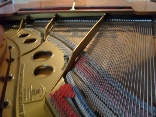


A thick horizontal line with two vertical endings (‘H’ bar) is the “modern” way of
denoting a rest lasting two more more bars, according to the number written over
the ‘H’ -

Repeated single notes are denoted with a diagonal bar -


The same conventions are used to denote repeated pairs of notes, sometimes in the form above, sometimes in the form below.
When the repetition of the note, or pair of notes, is meant to be as fast as possible, it’s a “tremolo” and this word should be added to the score to convey this meaning to the player.


Any arbitrary group of notes -


A group of semiquavers requires two closely spaced diagonal lines, demi-
“ Repeats” are just short-
- Identical or nearly identical sections of music
- Rests spanning many bars of music
- Repeated notes or groups of notes

Double bar-

Here section 1 is played three times. In the first 2 playings, bars 3 and 4 are played, but on the third playing, these bars are skipped and playing continues from bar 5

“D.C.” Stands for “Da Capo” and is found usually at the end of the piece. It means
go back to the beginning ( “da capo” -

“D.S.” Stands for “Dal Segno” and is found usually at the end of the piece. It means go back to the sign ( ) and play again up to “Fine” (final). Sometimes written out fully as “dal segno al fine”. Here, then section 1 is played, followed by section 2, and then finished off with playing of section 3.